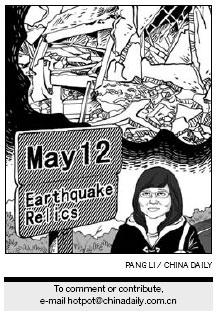'Quake relics' only reminder of 2008 disaster in Wenchuan
By Mei Jia (China Daily)
2011-03-23 09:35
 |
Large Medium Small |

News about the recent earthquakes in Yunnan province and Japan brought back memories of my last trip to Wenchuan, Sichuan province, in February.
I had gone to sweep the grave of my grandmother, who died in 2006 and wished to be buried there.
On the day the earthquake of May 12, 2008 hit, a big rock had rammed into a black car, pushing it toward the river but stopping just short.
I could tell because the car was still there on the banks of the river, the door of the driver's seat swung open, the rock on top of it.
I visited the places I was most familiar with and was overwhelmed by the inner strength shown by the people in these disaster-hit areas.
I was in Beijing when the earthquake hit Wenchuan.
My father called me just minutes after the catastrophe struck, saying he had run out of their shaking building in Chengdu, the provincial capital.

The telecommunication system was paralyzed soon after.
For three days after this call, I stood in tears in front of a TV screen, watching scene after scene of the horrific destruction the quake had wreaked.
Long before Wenchuan county, the epicenter, had hit the world's headlines, it was dear to me as a place I had visited several times with my grandmother who had close friends living there.
The Wenchuan of my childhood had only a mountain road running alongside the Minjiang River. The bumpy car ride to Wenchuan for the summer vacations, with everyone overcome by a queasy feeling, was nicely compensated for by the beauty of Qiang residences along the river.
The Qiang people's creativity, as seen in their colorful embroidery was also reflected in the decorations - of blooming flowers and images of their cloud-and-fire totems - covering the exterior walls of their square-shaped stone houses.
The heady scent from apple and Chinese prickly ash trees, lining the way leading to the bustling and dusty downtown area of the county, filled the air.
How much of this idyllic scene had changed, I wondered, as our car sped down the Dujiangyan-Wenchuan Highway to Yingxiu, one of the worst-hit areas.
It had been rebuilt in May 2009, but driving along the Minjiang River, I saw traces of the disaster, highlighted by dark maroon sign boards that read "May 12 Earthquake Relics".
The survivors now live in newly built houses, a fusion of modern and Qiang architecture.
Some of them are located near the relics and the people who live there share stories with family members of their old houses, now a pile of rubble.
They appeared at ease during the Spring Festival break, even with reminders of the disaster standing around the corner.
Wenchuan county looks brighter now with the newly constructed or restored buildings, that even add a stylistic touch to the old towns. "I didn't expect to see the county looking so stunning," said my mother, also making her first visit after the earthquake.
I felt relieved looking down on the town from one mountaintop, seeing the place etched in my memory revived by even brighter colors everywhere.
Although disasters such as earthquakes trigger losses at many levels, life finds a way of carrying on.
| 分享按钮 |